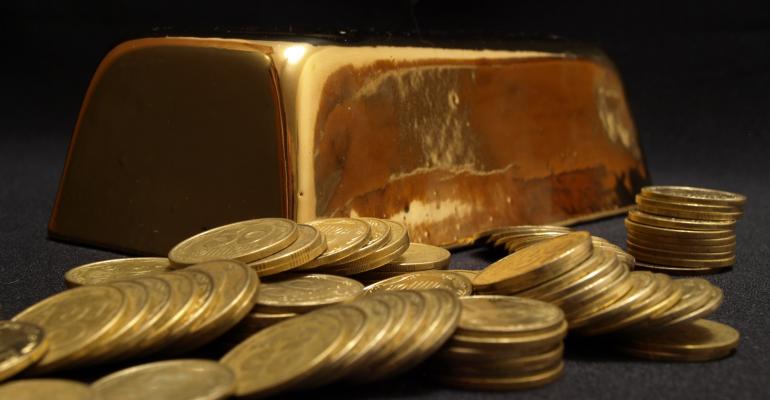Bearish sentiment in precious-metal markets reached new extremes during the month of July. By some measures, bearish positioning in gold futures reached unprecedented levels. During the week ended July 21, figures from the U.S. Commodity Futures Trading Commission disclosed that money managers and hedge funds in aggregate held a net short position in gold futures for the first time since the U.S. government began collecting the data in 2006. Similarly, the gross-short component of speculator positioning reached an all-time high. During the following week, the aggregate positioning of traditionally short commercial participants (jewelry manufacturers and bullion banks) reached its lowest level since 2001. At least in “paper” gold markets, positioning has never been more bearish.
Unbridled resolve of gold shorts was on display during the evening of Sunday July 19. In the notoriously thin hours of NY Globex Access Market trading, sellers dumped 7,600 contracts (24 tonnes) in a two-minute span beginning less than one minute prior to the opening of the Shanghai Gold Exchange. On the open in Shanghai, an additional 33 tonnes were liquidated during the first minute of trading. All told, some 57 tonnes worth of gold ($2 billion notional value) were sold in a two-minute span during normally sleepy hours of gold trading, causing a $50 dislocation in the gold price. We would observe that multi-billion-dollar Sunday night raids, however, suggest negative sentiment may be reaching crescendo.
We always find the dichotomy between cascading prices of gold futures and simultaneous spikes in underlying demand for physical metal to be a fascinating aspect of gold markets. True to form, the mid-July price dislocation in gold markets has unleashed strong physical demand in all the usual locales. In the United States, U.S. Mint sales of gold eagle coins jumped over 100% (m/m) in July, reaching the highest level since April 2013 (when gold experienced a six-standard-deviation price dislocation). In India, where ex-duty premiums had remained negative for some 2 1Ž2 months, premiums soared to high-single digit levels in mid-July (where they have since remained). In China, physical deliveries from the Shanghai exchange have gone absolutely ballistic, culminating in a 207.834 tonne offtake in two consecutive days this week (95.380 tonnes on 8/4/15 and 112.454 tonnes on 8/5/15). With all due respect to COMEX gold bears, when the Shanghai Exchange finds physical buyers for what amounts to 7% of annual global mine production in just two days, we would suggest prevailing gold prices are likely to lurch significantly higher.
In mid-July, the People’s Bank of China updated its official gold reserves as 1658 tonnes, or 604 tonnes higher than its last update in April 2009. Given the length of elapsed time, the magnitude of this increase was disappointing to many market observers. While we would count ourselves among those surprised the announced increase was not larger, we offer a few observations.
- Our understanding is the PBOC balance sheet does not necessarily reflect gold holdings which may reside at the State Administration of Foreign Exchange, the Postal Savings Bank or the Chinese commercial banking system.
- With inclusion of the renminbi in the International Monetary Fund Special Drawing Rights basket under review, it would make sense that China may not have viewed July as the most opportune juncture to flash significant gold holdings. Given U.S. skepticism over renminbi SDR inclusion, as well as U.S. dominance of IMF voting rights, China may have viewed announcing large gold holdings as an inopportune challenge to the status quo of the dollar reserve system. Now that IMF staff have postponed review of renminbi inclusion until September 2016 (announced 8/5/15), it will be interesting to see if China voices any displeasure by releasing incremental disclosure of gold reserves.
- We view non-official accumulation of gold in China as a far more compelling variable than PBOC disclosures. Since 2009, Shanghai deliveries now exceed 9,000 tonnes, significantly more than even the (stated) U.S. official reserves of 8,100 tonnes.
In mid-May, we suggested that reigning bearish gold sentiment rested squarely on four assumptions in the process of being disproved and which we predicted would remain challenged during the course of 2015:
- Consensus expectations for continued U.S. dollar strength
- Aggressive FOMC tightening
- Escape velocity U.S. economic performance and
- Further gains in U.S. equities
Since that time, the dollar has risen 2%, stocks have declined 1%, GDP has clearly decelerated and the FOMC has yet to move. Given exceptionally bearish positioning in gold markets, we believe current prices in the gold complex may serve as a particularly fortuitous entry point.
Trey Reik is a Senior Portfolio Manager and Precious Metals Strategist at Sprott Asset Management USA, a division of Sprott Inc., a Toronto-based alternative asset manager. He is also the author of The Sprott Precious Metals Watch, a monthly newsletter produced by Sprott Asset Management LP.





